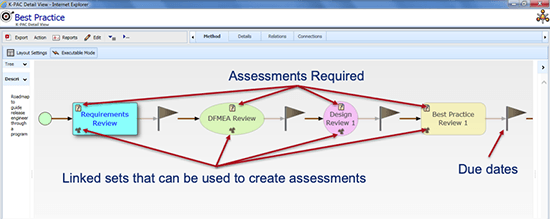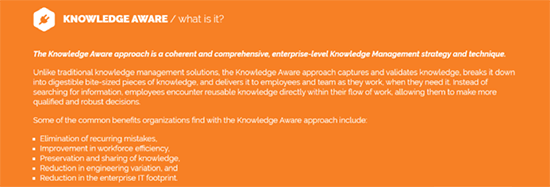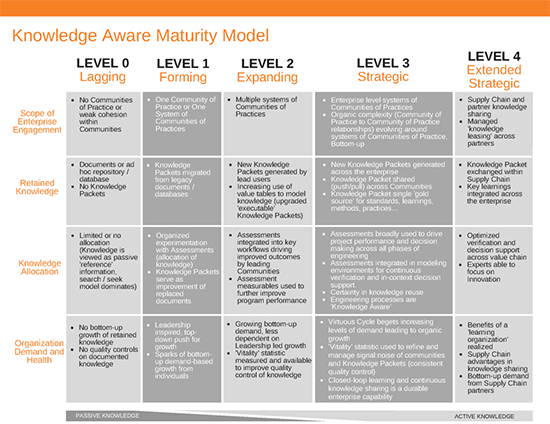CIMdata executive consultant and former GM PLM Leader, Craig Brown, shared his insights on the need for enterprise knowledge management as a capability distinct from PLM and requirements engineering. Craig discussed his specific experiences as Auros adoption expanded across many domains and workflows at his former organization.
Auros Knowledge Systems Showcased in Recent CIMdata Commentary and Knowledge Aware Conference Presentation
Presentation at the 2019 Knowledge Aware Conference, “Experiences with Knowledge Aware and Auros”
General Motors developed PLM Themes a decade ago to drive PLM Innovation. “Just the Right Information, to Just the Right People, at Just the Right Time” became our rallying cry. Themes included Connect People, Visual It, and Apply Knowledge. Auros was first applied by small groups within GM to aid in Knowledge-Based Engineering. KBE applications used Auros based criteria to automate key designs occurring on the critical path of product development. As our experiences grew, more and more users explored using Auros and expansion grew from the grassroots. A summary of the journey and how Auros helps “Apply Knowledge” will be presented by Craig Brown as he recalls the expansion with GM.
About Craig Brown

Executive Consultant (2019 – Present)
CIMdata
PLM Leader (1995 – 2019)
Global Engineering Systems Development & PLM
General Motors
Craig Brown has 40 years of experience in systems engineering, both in the automotive and aerospace industries. He manages engineering and IT teams developing tools to improve product engineering. These teams have received patents, engineering awards, and records of inventions. Craig received GM’s Boss Kettering Award in 2003, using OnStar to monitor and report Vehicle Diagnostics. The acquisition of knowledge applied across product portfolios is key to the next wave of Product Lifecycle Management. Craig was appointed the GM PLM Leader in September 2012. He became PLM World’s Community Director in 2015. He retired from GM in early 2019 and looks forward to helping others apply their knowledge, experiences, and wares into the digital enterprises of the future.
CIMdata Commentary, “Auros Knowledge Systems Makes Knowledge Active” by Craig Brown (CIMdata)
View commentary on CIMdata’s website / Download PDF
Key takeaways:
- Knowledge must be easy to record, review, comprehend, and apply.
- Knowledge is applied throughout product lifecycles and is often viewed in a comparative way (peer reviews, similar products, field failures, etc.).
- PLM/PDM/ALM systems manage resulting design throughout a product lifecycle, but institutional knowledge lasts longer than any individual product’s lifecycle.
- Knowledge has a lifecycle related to proven practices and technology application.
The application of experience, knowledge, and practice are hallmarks of any successful enterprise. When solving problems, whatever their source, one often relies on recorded, reliable, peer approved knowledge gained through experience. The practical use of knowledge changes as the underlying technology changes, but at a duration much longer than a product’s lifecycle. Most products have histories of small incremental improvements where the manufacturing, service, and use of knowledge is stable. The next product benefits from the application of institutional knowledge. Successful management and application of knowledge reduces recurring mistakes and improves efficiency.
What is Knowledge Management
Design and release systems, typical tools for product design and manufacturing, are not optimized for the lifecycle of knowledge. Learnings often come from experiences not anticipated by the original designers. The capture, indexing, and application of these experiences is a valuable corporate knowledge asset. Managing these insights builds a knowledge base and often provides competitive advantages.
Auros’ Journey
Auros Knowledge Systems emerged from the automobile engineering community, seeking to radically improve how organizations around the globe capture, share, and reuse knowledge. Fulfilling this need at Ford, GM, and other companies has made Auros a leading enterprise solution for a fundamentally new approach to managing technical knowledge—called ‘Knowledge Aware.’
Auros Knowledge Systems was founded during the time that computer aided design (CAD) was expanding in mass production companies. While CAD and product data management (PDM) solutions, and now product lifecycle management (PLM) solutions, have rules applied to specific designs many lack an intuitive and reliable approach to managing and provisioning institutional knowledge that applies across multiple products and designs. Auros nurtured a growing community inside large manufacturers to develop a notion of making institutional knowledge active, where engineering processes became aware of captured knowledge. Knowledge was not represented in some paragraphs of insight, like an entry in an encyclopedia, but was inherently active (e.g., knowledge was actively reused by knowledge-based engineering (KBE) applications in design automation). KBE applications included solutions for packaging and interface challenges for a family of necessary but auxiliary parts on automobiles. Examples include oil dip stick routing and wiper design aids. For instance, the wiper application enforces federal Motor Vehicle Safety Standards (MVSS) rules based on percentage of windshield that must be cleared by a wiper system. These are but a few examples of design automation enabled by Auros’ Knowledge Systems tool. Another important domain for active knowledge is the provisioning of manufacturing best practices as applied to the development of the Bill of Process (BoP) to include techniques learned from experience in mass production. Examples of this type of institutional knowledge include bending, casting, melting, and assembly rules and best practices. A key aspect in applying institutional knowledge is that a comprehendible piece of knowledge must be easy to learn. This is best accomplished by limiting (or right-sizing) the supporting prose. To this end, Auros developed their Knowledge Packet concept with guidelines on what a good knowledge packet contains. Another concept is that multiple knowledge packets can be combined and provisioned together as a set to accommodate real world complexity.
Organic Growth to Broader Audiences
Three factors have been instrumental in Auros Knowledge Systems’ success: ease of knowledge capture, design automation with actionable requirements (dimensions and performance), and timely application of knowledge packets synchronized with a product plan. Let’s explore each one.
Knowledge capture often comes from a learning experience (examples include a field failure or a failed validation test). The person who authors the conclusion, creating a form of knowledge, is almost never the original designer who is familiar with the PLM and ALM tools. The authors of this knowledge are often experts in demand. The user experience to capture knowledge is driven by familiarity and ease of use. This helps avoid multiple mouse clicks required to associate knowledge to a specific design, which is usually very time consuming. So, the system to capture knowledge must have a very different user experience. Furthermore, the knowledge gained from experience is often judged and approved by an expert group. Their ease of reviewing and approving knowledge is critical.
Rules and key measures captured in executable knowledge packets can be accessed by design automation and assembly tools to remove human error and to speed packaging work. The first such applications of this type were developed and in use in the mid-2000s. However, not all knowledge is inherently applicable to CAD, CAE, and other digital tools. Nonetheless, these types of knowledge packets are still structured in a way such that the knowledge consumer can quickly determine the appropriate course of action. Applying knowledge packets at the best time is also critical. It can be overwhelming to apply all institutional knowledge consistently to a new product. Companies develop a succession of phases and gate reviews to decide key design points before proceeding to the next phase. Being able to see that specific knowledge to be applied for a specific phase helps manage the application of knowledge in a timelier and consumable fashion. Figure 1 shows an example of a Best Practice.

Figure 1—Best Practice Knowledge Use Process
(Courtesy of General Motors and Auros—Knowledge Aware 2018)
Finally, knowledge can be captured at any time and acted upon by any product, regardless of its point in the lifecycle. Peer reviews and field response teams often have a need for the latest experience to be applied to fixes or design evolutions. Active knowledge can be very important for new technology introductions where experience is lacking. Being able to proactively review and apply field insights early in a product’s lifecycle is beneficial to consumers and OEMs. As peers see the application in use, expansion occurs to many learning situations where discovered knowledge wants to be applied to other products throughout their lifecycles. Auros Knowledge Aware support these concepts as described in Figure 2.

Figure 2—Auros’ Knowledge Aware Key Concepts
(Courtesy Knowledge Aware 2019, www.kaconference.org)
The journey from passive knowledge to active knowledge has key attributes that have been captured and published in the Knowledge Aware Maturity Model. Similar to CMMI for software and systems, the Knowledge Aware Maturity Model shown in Figure 3 provides a way for organizations to assess where they are on the journey to active knowledge management. The Knowledge Aware user community has embraced this maturity model to help them guide their improvement plans.

Figure 3— Knowledge Aware Maturity Model
(Courtesy of Auros)
CIMdata believes that the Auros Knowledge Management solution offers an appealing choice for any discrete manufacturing company who has the need to capture and proactively apply knowledge. Application is especially valuable in companies that produce similar products in parallel, year after year. The Knowledge Aware Maturity Model allows a company to quickly assess where they are on the knowledge management journey. Capture of knowledge relies on experts with less and less time and ease of use is paramount. Auros Knowledge Aware solution is proven given its diverse applications beyond designers.



